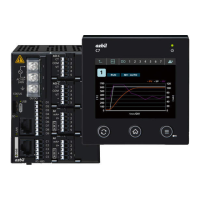vii
DI/DO block (7 digital inputs or outputs, selectable) 3-8
RS-485 (RS-485 communication port) 3-9
Analog input block (analog input) 3-10
Analog input block layout 3-11
Analog output block (current outputs, CT inputs, and VT inputs) 3-12
Voltage pulse output block (voltage pulse outputs and 2 CT inputs) 3-13
DI block (4 digital inputs) 3-14
DO block (4 digital outputs, sink output) 3-14
MOTOR block (motor drive outputs and motor feedback inputs) 3-15
I/O isolation 3-16
USB connection 3-16
Inserting or removing a microSD memory card 3-17
Connecting the LAN cable for Ethernet 3-17
Connecting the cable between the main unit and display unit 3-18
Chapter 4. Functions 4-1
4 - 1 Loop Types
4-1
Model numbers and loop types 4-1
Setting the loop type 4-4
4 - 2 AI (Analog Input) 4-6
Range types 4-7
Linear scaling low and high limits 4-7
Setting the linear input unit character 4-7
Filter 4-8
Ratio and bias 4-9
Linearization table group definition 4-9
Number of decimal places for PV 4-9
Sampling cycle 4-10
PV Hold 4-10
Power supply frequency 4-10
4 - 3 Mode 4-12
AUTO/MANUAL mode 4-12
Constant value operation / Pattern operation 4-13
RUN/READY mode 4-14
LSP/RSP mode 4-14
Pattern start number 4-15
READY/RUN/HOLD/END mode 4-15
ADVANCE 4-17
G.SOAK clear 4-18
AT (auto-tuning) stop/start 4-18
4 - 4 Control 4-19
Functional block diagram of PID control 4-19
Functional block diagram of ON/OFF control 4-19
Functional block diagram of heating/cooling control 4-20
Control action 4-20
Heating/cooling control dead zone 4-21

